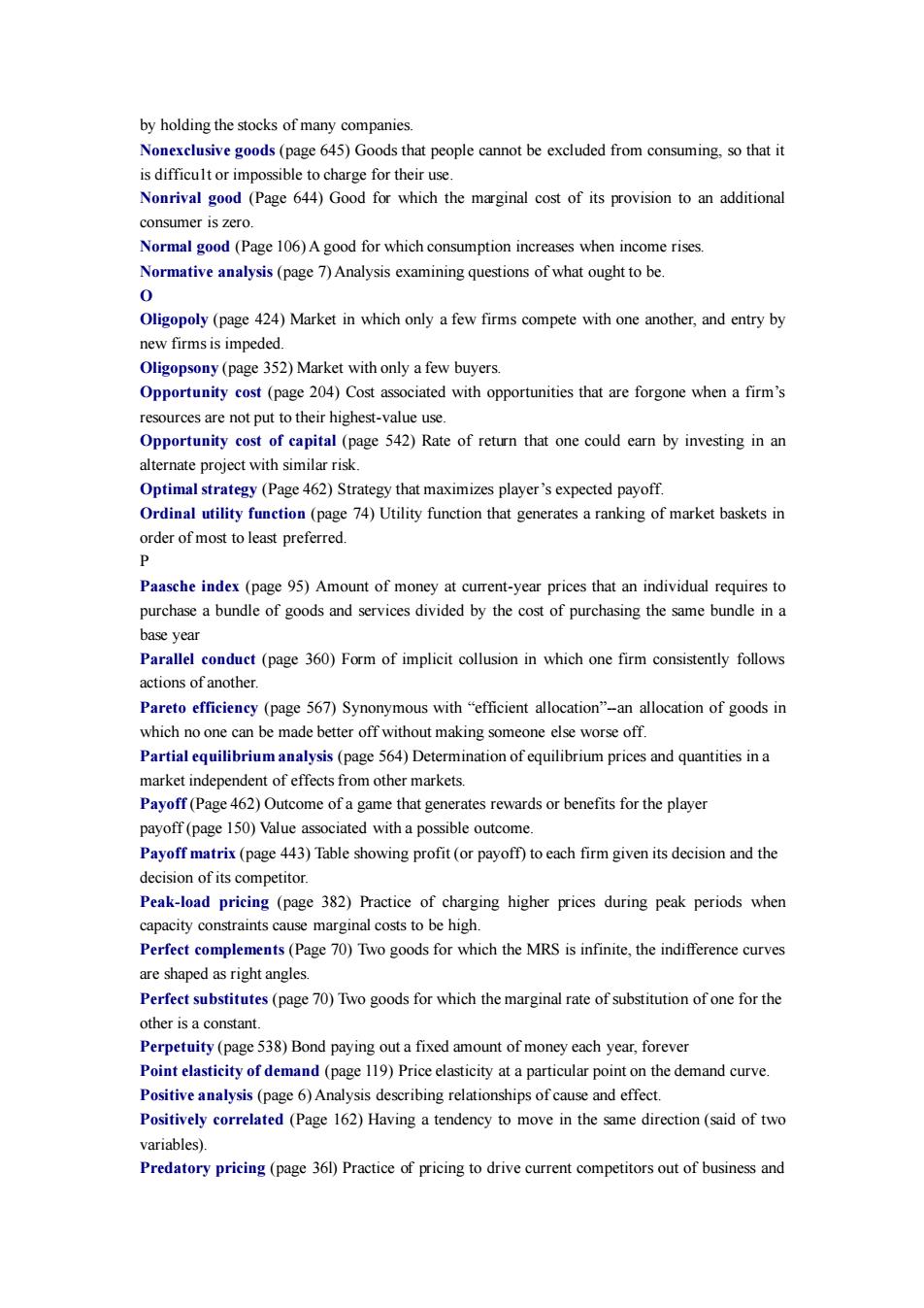正在加载图片...

by holding the stocks of many companies. sdimiecultorimpe sible tocharge for theirus Nonrival good (Page 644)Good for which the marginal cost of its provision to an additional consumer is zero. Normal good (Page 106)A good for which consumption increases when income rises. Normative analysis(page 7)Analysis examining questions of what ought to be. 0 Oligopoly (page 424)Market in which only a few firms compete with one another,and entry by new firms is impeded Oligopsony (page 352)Market with only a few buyers. Opportunity cost(page 204)Cost associated with opportunities that are forgone when a firm's not putto their highest-vaueus Opportunity cost of capital (page 542)Rate of retun that one could earn by investing in an alternate project with similar risk. Optimal strategy (Page 462)Strategy that maximizes player's expected payoff. Ordinal utility fumction(page 74)Utility function that generates a ranking of market baskets in order of most to least prefer 6 Paasche index(page 95)Amount of money at current-year prices that an individual requires to purchase a bundle of goods and services divided by the cost of purchasing the same bundle in a hase year Parallel conduct(page 360)Form of implicit collusion in which one firm consistently follows actions of Pareto efficieney (page 567)Synonymous with"efficient allocation"an allocation of goods in which no one can be made better off without making someone else worse off. Partial equilibriumanalysis(page 564)Determination of equilibrium prices and quantities in a market independent of effects from other markets. Payoff (Page 462)Outcome of a ga me that gen ates ards or benefits for the plaver payoff(page 15)Value as Payoff matrix(page 443)Table showing profit(or payoff)to each firm given its decision and the decision of its competitor. Peak-load pricing(page 382)Practice of charging higher prices during peak periods when capacity constraints aus marginal costs to be high (Page )Two goods for which the MRS,the are shaped as right angles Perfeet substitutes(page 70)Two goods for which the marginal rate of substitution of one for the other is a constant Perpetuity(page538)Bond paying out a fixed amount of money each year,forever Point elas of demand(pag 119)Price elasti city (page6)Analysis escribing effect Positively correlated (Page 162)Having a tendency to move in the same direction (said of two variables). Predatory pricing(page 361)Practice of pricing to drive current competitors out of business and by holding the stocks of many companies. Nonexclusive goods (page 645) Goods that people cannot be excluded from consuming, so that it is difficu1t or impossible to charge for their use. Nonrival good (Page 644) Good for which the marginal cost of its provision to an additional consumer is zero. Normal good (Page 106) A good for which consumption increases when income rises. Normative analysis (page 7) Analysis examining questions of what ought to be. O Oligopoly (page 424) Market in which only a few firms compete with one another, and entry by new firms is impeded. Oligopsony (page 352) Market with only a few buyers. Opportunity cost (page 204) Cost associated with opportunities that are forgone when a firm’s resources are not put to their highest-value use. Opportunity cost of capital (page 542) Rate of return that one could earn by investing in an alternate project with similar risk. Optimal strategy (Page 462) Strategy that maximizes player’s expected payoff. Ordinal utility function (page 74) Utility function that generates a ranking of market baskets in order of most to least preferred. P Paasche index (page 95) Amount of money at current-year prices that an individual requires to purchase a bundle of goods and services divided by the cost of purchasing the same bundle in a base year Parallel conduct (page 360) Form of implicit collusion in which one firm consistently follows actions of another. Pareto efficiency (page 567) Synonymous with “efficient allocation”-an allocation of goods in which no one can be made better off without making someone else worse off. Partial equilibrium analysis (page 564) Determination of equilibrium prices and quantities in a market independent of effects from other markets. Payoff (Page 462) Outcome of a game that generates rewards or benefits for the player payoff (page 150) Value associated with a possible outcome. Payoff matrix (page 443) Table showing profit (or payoff) to each firm given its decision and the decision of its competitor. Peak-load pricing (page 382) Practice of charging higher prices during peak periods when capacity constraints cause marginal costs to be high. Perfect complements (Page 70) Two goods for which the MRS is infinite, the indifference curves are shaped as right angles. Perfect substitutes (page 70) Two goods for which the marginal rate of substitution of one for the other is a constant. Perpetuity (page 538) Bond paying out a fixed amount of money each year, forever Point elasticity of demand (page 119) Price elasticity at a particular point on the demand curve. Positive analysis (page 6) Analysis describing relationships of cause and effect. Positively correlated (Page 162) Having a tendency to move in the same direction (said of two variables). Predatory pricing (page 36l) Practice of pricing to drive current competitors out of business and